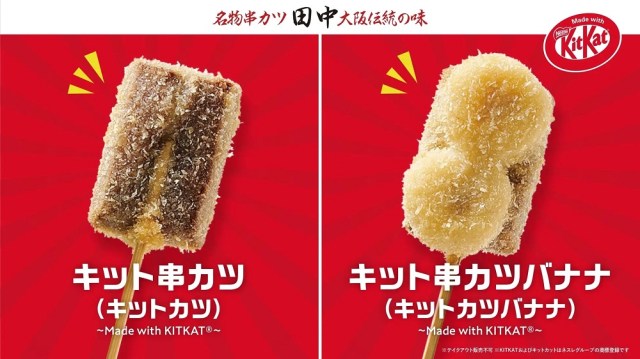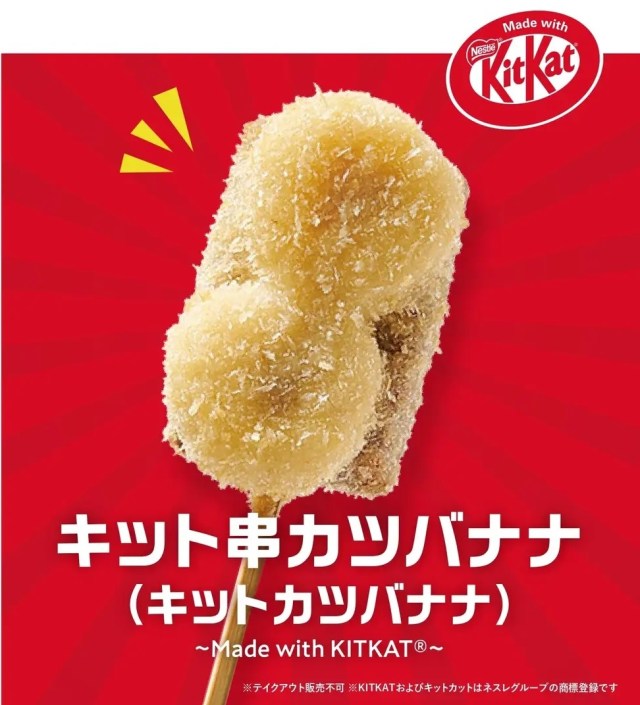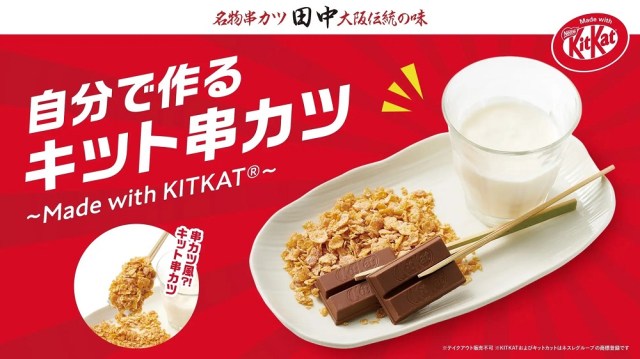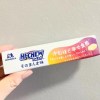
Sweet, savory, and doubly lucky.
There’s no country on earth that loves KitKats quite like Japan. All of those amazing seasonal and regional-exclusive KitKat flavors, though, didn’t come about until after the standard KitKat’s big break in Japan, which it owes to a pun.
In Japanese, KitKat gets pronounced “Kitto Katto,” which sounds very close to the Japanese words kitto (“I think” or “I believe”) and katsu (“win” or “succeed”). When people noticed the similarity, they started gifting or carrying a pack of KitKats in their bag on important days, like entrance exams or job interviews, as a “I believe you/I will succeed” good-luck charm, making the chocolate wafers a symbol of hope, friendship, and emotional support.
But if you spend a lot of time thinking about Japanese food and Japanese linguistics, you might be ready to point out that katsu is also the Japanese word for deep-fried cutlets, which is why Japan is now getting deep-fried KitKats.
In hindsight, it seems like KitKat katsu are something that should have happened years ago. Better late than never, though, especially when fried foods and sweets are involved, and we can thank restaurant chain Kushi Katsu Tanaka for finally realizing the need to make this dessert a reality.
Kushi katsu, Tanaka’s marque menu item, are deep-fried morsels served on a skewer. It’s a broad culinary style adaptable to all sorts of meats, seafood, and vegetables. Dessert kushi katsu are much rarer, though not completely unheard of, but deep-fried KitKats are a bold new step for the kushi katsu culinary sphere.
Tanaka isn’t going into this timidly, either, as they’re offering three different kushi katsu KitKats. There’s the basic Kitto Kushi Katsu, pictured above, with two of the chocolate wafer sticks fried up for 150 yen (US$1). If you’re feeling fancy, there’s also the 170-yen Kitto Kushi Katsu Banana, which adds slices of banana as a pre-frying topping to the KitKat.
And for do-it-yourself-types, there’s the Make Your Own Kitto Kushi Katsu, a 290-yen set of two KitKat skewers and a cup of yogurt sauce to dip them in so you can then coat them in corn flakes, which are a popular ingredient in Japanese parfaits.
▼ With yogurt and cereal, you might even be able to convince yourself that this is a pretty sensible breakfast.
By the way, if you’re wondering if the good-luck properties associated with KitKat because it sounds like katsu are applied to the food that’s actually called katsu too, they are, and cutlets are also a popular meal choice for Japanese people on important days. So by that logic, eating these KitKat katsu should be doubly auspicious, and we should all probably try to consume as many as we can while they’re on the Kushi Katsu Tanaka menu from November 1 to 30.
Source: PR Times via IT Media
Images: PR Times
● Want to hear about SoraNews24’s latest articles as soon as they’re published? Follow us on Facebook and Twitter!




 All-plant-based katsu curry arrives at Ikea Japan
All-plant-based katsu curry arrives at Ikea Japan We try making a low-calorie katsu with tofu instead of pork【SoraKitchen】
We try making a low-calorie katsu with tofu instead of pork【SoraKitchen】 The U.K. thinks Japanese curry is katsu curry, and people aren’t happy about it
The U.K. thinks Japanese curry is katsu curry, and people aren’t happy about it KitKat Mcflurry comes to McDonald’s Japan with commercial starring Japanese idol
KitKat Mcflurry comes to McDonald’s Japan with commercial starring Japanese idol Katsudon vs. tonkatsu vs. katsu sandwich – What’s the best way to eat pork cutlet in Japan?
Katsudon vs. tonkatsu vs. katsu sandwich – What’s the best way to eat pork cutlet in Japan? Foreigner’s request for help in Tokyo makes us sad for the state of society
Foreigner’s request for help in Tokyo makes us sad for the state of society Japanese-style accommodation at the new Premium Dormy Inn hotel in Asakusa will blow your mind
Japanese-style accommodation at the new Premium Dormy Inn hotel in Asakusa will blow your mind Seaside scenery, history, and so many desserts on Yokohama’s Akai Kutsu【Japan Loop Buses】
Seaside scenery, history, and so many desserts on Yokohama’s Akai Kutsu【Japan Loop Buses】 Do Hi-Chew-flavor Hi-Chews have a reason to exist?【Taste test】
Do Hi-Chew-flavor Hi-Chews have a reason to exist?【Taste test】 Japan’s summertime towelket pillowcases are even better with the addition of Ghibli stars【Photos】
Japan’s summertime towelket pillowcases are even better with the addition of Ghibli stars【Photos】 Mikado Coffee is a 76-year-old coffee chain with a major celebrity connection
Mikado Coffee is a 76-year-old coffee chain with a major celebrity connection A trip to hell on Japan’s ‘vomit ship’: Is it as bad as everyone says it is?
A trip to hell on Japan’s ‘vomit ship’: Is it as bad as everyone says it is? After eight years as a NEET, our reporter shares the one thing that helped him escape that life
After eight years as a NEET, our reporter shares the one thing that helped him escape that life Haku is…Chihiro’s dead brother? Studio Ghibli fans blown away by Spirited Away theory
Haku is…Chihiro’s dead brother? Studio Ghibli fans blown away by Spirited Away theory French Fries Bread in Tokyo’s Shibuya becomes a hit on social media
French Fries Bread in Tokyo’s Shibuya becomes a hit on social media McDonald’s new Happy Meals offer up cute and practical Sanrio lifestyle goods
McDonald’s new Happy Meals offer up cute and practical Sanrio lifestyle goods Japanese ramen restaurants under pressure from new yen banknotes
Japanese ramen restaurants under pressure from new yen banknotes Red light district sushi restaurant in Tokyo shows us just how wrong we were about it
Red light district sushi restaurant in Tokyo shows us just how wrong we were about it New private rooms on Tokaido Shinkansen change the way we travel from Tokyo to Kyoto
New private rooms on Tokaido Shinkansen change the way we travel from Tokyo to Kyoto Tokyo Tsukiji fish market site to be redeveloped with 50,000-seat stadium, hotel, shopping center
Tokyo Tsukiji fish market site to be redeveloped with 50,000-seat stadium, hotel, shopping center Japanese city loses residents’ personal data, which was on paper being transported on a windy day
Japanese city loses residents’ personal data, which was on paper being transported on a windy day Beautiful Ghibli sealing wax kits let you create accessories and elegant letter decorations【Pics】
Beautiful Ghibli sealing wax kits let you create accessories and elegant letter decorations【Pics】 Secret Kitchen bento serves Japanese flowers, birds, wind and moon in a box, but is it worth it?
Secret Kitchen bento serves Japanese flowers, birds, wind and moon in a box, but is it worth it? New definition of “Japanese whiskey” goes into effect to prevent fakes from fooling overseas buyers
New definition of “Japanese whiskey” goes into effect to prevent fakes from fooling overseas buyers Our Japanese reporter visits Costco in the U.S., finds super American and very Japanese things
Our Japanese reporter visits Costco in the U.S., finds super American and very Japanese things Studio Ghibli releases Kiki’s Delivery Service chocolate cake pouches in Japan
Studio Ghibli releases Kiki’s Delivery Service chocolate cake pouches in Japan All-you-can-drink Starbucks and amazing views part of Tokyo’s new 170 meter-high sky lounge
All-you-can-drink Starbucks and amazing views part of Tokyo’s new 170 meter-high sky lounge More foreign tourists than ever before in history visited Japan last month
More foreign tourists than ever before in history visited Japan last month New Pokémon cakes let you eat your way through Pikachu and all the Eevee evolutions
New Pokémon cakes let you eat your way through Pikachu and all the Eevee evolutions Disney princesses get official manga makeovers for Manga Princess Cafe opening in Tokyo
Disney princesses get official manga makeovers for Manga Princess Cafe opening in Tokyo Sales of Japan’s most convenient train ticket/shopping payment cards suspended indefinitely
Sales of Japan’s most convenient train ticket/shopping payment cards suspended indefinitely Sold-out Studio Ghibli desktop humidifiers are back so Totoro can help you through the dry season
Sold-out Studio Ghibli desktop humidifiers are back so Totoro can help you through the dry season Japanese government to make first change to romanization spelling rules since the 1950s
Japanese government to make first change to romanization spelling rules since the 1950s Ghibli founders Toshio Suzuki and Hayao Miyazaki contribute to Japanese whisky Totoro label design
Ghibli founders Toshio Suzuki and Hayao Miyazaki contribute to Japanese whisky Totoro label design Doraemon found buried at sea as scene from 1993 anime becomes real life【Photos】
Doraemon found buried at sea as scene from 1993 anime becomes real life【Photos】 Tokyo’s most famous Starbucks is closed
Tokyo’s most famous Starbucks is closed One Piece characters’ nationalities revealed, but fans have mixed opinions
One Piece characters’ nationalities revealed, but fans have mixed opinions We asked a Uniqlo employee what four things we should buy and their suggestions didn’t disappoint
We asked a Uniqlo employee what four things we should buy and their suggestions didn’t disappoint New Japanese KitKat captures the flavour of Baskin Robbins’ choc mint ice cream
New Japanese KitKat captures the flavour of Baskin Robbins’ choc mint ice cream Katsu isn’t curry! Four kinds of katsu, and three delicious ways to eat them【Video】
Katsu isn’t curry! Four kinds of katsu, and three delicious ways to eat them【Video】 World’s first make-your-own KitKat shop is opening in Tokyo
World’s first make-your-own KitKat shop is opening in Tokyo Japan is getting apple pie-flavor KitKats with help from a 136-year-old sweets shop
Japan is getting apple pie-flavor KitKats with help from a 136-year-old sweets shop KFC puts its own spin on Japanese flavours with the new Katsu and Fillet Burger
KFC puts its own spin on Japanese flavours with the new Katsu and Fillet Burger How to make an imitation katsudon pork cutlet bowl using imitation katsu【SoraKitchen】
How to make an imitation katsudon pork cutlet bowl using imitation katsu【SoraKitchen】 Celebrities slam katsu curry, divide netizens: “It’s a dish where 1+1 never actually makes 2”
Celebrities slam katsu curry, divide netizens: “It’s a dish where 1+1 never actually makes 2” New Japanese KitKat flavour, Sugar Butter Tree, is like cracking a chocolate tree branch
New Japanese KitKat flavour, Sugar Butter Tree, is like cracking a chocolate tree branch New winter-only Japanese KitKat flavour combines chocolate with a decadent sweet
New winter-only Japanese KitKat flavour combines chocolate with a decadent sweet Unlimited kushiage skewers, stewed oden, and booze at this Tokyo restaurant for under 20 bucks
Unlimited kushiage skewers, stewed oden, and booze at this Tokyo restaurant for under 20 bucks New Japanese KitKat is…a Heartful Bear!
New Japanese KitKat is…a Heartful Bear! Mr. Sato takes a break in the new Shibuya KitKat Chocolatory, has a custom KitKat
Mr. Sato takes a break in the new Shibuya KitKat Chocolatory, has a custom KitKat Katsudon for breakfast? Japan’s new bacon egg cutlet bowl may be the only meal we need all day
Katsudon for breakfast? Japan’s new bacon egg cutlet bowl may be the only meal we need all day New Japanese KitKats combine ruby chocolate with everyday nuts and cranberry
New Japanese KitKats combine ruby chocolate with everyday nuts and cranberry We eat at Tokyo’s first vegan Japanese-style convenience store in Asakusa
We eat at Tokyo’s first vegan Japanese-style convenience store in Asakusa
Leave a Reply